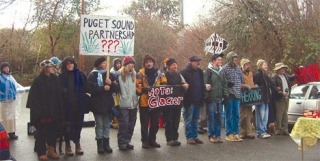Protesters with their arms in long steel tubes created a human chain blocking the road that leads to Glacier Northwest’s mine site Friday morning — the first act of civil disobedience to halt the mine’s controversial expansion since it was proposed more than a decade ago.
At two different sites on S.W. 260th Street, nine protesters formed what they called a “hard blockade,” keeping workers from driving to the mine’s site on the eastern edge of Maury Island. Dozens of others supported them, offering up food, coffee and back-rubs and acting as a “soft blockade” — or the first line of defense — as workers in their cars and trucks approached.
The protesters did not try to block people on foot, however. Ultimately, about a dozen workers got out of their rigs and walked around the phalanx of protesters, trudging several hundred yards to Glacier’s site.
“Would you like some muffins or coffee?” one protester asked as a pair of workers strode past.
“Nope. I’m already late for work,” one worker answered.
The protest started at 5 a.m., early enough to block the first crews arriving to work on the barge-loading pier that the corporation began building Dec. 5. It broke up at 10:30 a.m., when protesters, toting binoculars, were able to walk to a bluff, look down at the site and see that the construction company’s floating crane was operating.
No one was arrested.
“I feel like we accomplished something and that this is a start,” said Aleythea Dolstad, a fifth-generation Islander, after she pulled her arm out of the steel tube. “We’ve touched the workers and given them something to think about.”
“I’m happy about it,” said Daniel Haag, 25. “It could have been better. It would have been ideal for them not to have worked at all today. But it was still good. It was nonviolent.”
Bill Moyer with the Backbone Campaign, which helped to organize Friday’s event, said he was encouraged that the protesters were able to slow work for a few hours — noting that no court has yet to do that.
“If it stirs the imagination of our community and shows them that it’s not over and that there are creative tactics we can use, … then we’ve achieved something,” he said.
The effort got under way in the pre-dawn darkness, when dozens of Islanders, gathering at the two different sites, set up an extensive operation. The men and women in the hard blockade sat on milk crates, bundled in heavy coats and boots; the two on each end had a steel tube that reached into a drum of cement. Each one sported a blue laminated tag on their coats: “We are nonviolent. We love Puget Sound.”
An outdoor grill provided a fire that some of the support people gathered around; tables with coffee, tea and baked goods were set up.
Many held colorful signs, including cut-outs of fish that showed them as flesh-covered animals on one side, skeletons on the other. One woman was there with her 13-month-old baby, held against her chest in a colorful sling; others were there with small children. At one point, thick snowflakes began to fall.
A worker, sitting in the cab of his truck, stared at the scene in front of him. “First time I’ve ever seen something like this,” he said.
John Sellers, an Islander and one of the founders of the Ruckus Society, a California-based group that provides training and support for people and groups involved in direct action, said he felt pleased that they were actually keeping workers from the site. The effort, as a result, was not simply symbolic, it was also a “tactical victory,” he said.
Amy Carey, who heads Preserve Our Islands, agreed, calling the outpouring “a phenomenal thing.”
“I know right now there’s not construction happening,” she said at one point during the event, while workers sat in their trucks. “For the moment, it’s a safe place.”



